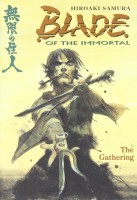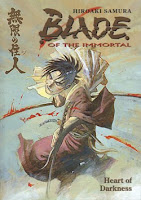 Creator: Takehiko Inoue
Creator: Takehiko Inoue
U.S. publisher: Viz Media
ISBN: 9781421522449
Released: December 2008
Original release: 1999-2000
Awards: Japan Media Arts Award, Kodansha Manga Award, Tezuka Osamu Cultural Prize
The second Vagabond omnibus, published by Viz Media in 2008, collects the fourth through sixth volumes of Takehiko Inoue’s award-winning manga series Vagabond. These three volumes were originally released in Japan between 1999 and 2000 and were published in English by Viz Media as individual volumes between 2002 and 2003 before being collected into an omnibus. Inoue’s Vagabond is based on Eiji Yoshikawa’s epic historical novel Musashi, which I made a point to read before delving into the manga series. So far, I have really been enjoying Inoue’s version of Japan’s legendary swordsman Miyamoto Musashi. And I’m not the only one. Vagabond received both a Japan Media Arts Award and a Kodansha Manga Award in 2000 and then a Tezuka Osamu Cultural Prize in 2002. Because June 2012’s Manga Moveable Feast focused on the work of Takehiko Inoue, I figured it was a good opportunity to look at Vagabond again.
After Miyamoto Musashi’s duel with Yoshioka Denshichirō is forced to a draw, the walls of the Yoshioka dōjō in flames around them, the injured young swordsman takes the opportunity to leave Kyoto. It is agreed that he and Denshichirō will meet to fight again in a year’s time, allowing them both to recover and improve their swordsmanship, assuming they can survive that long. Denshichirō might not have much of a problem in that regard, but there are several people after Musashi’s life, including Gion Tōji, a highly skilled swordsman from the Yoshioka school who blames Musashi for its destruction. Now more than ever Musashi is determined to become invincible, deliberately seeking out talented martial artists and challenging them to fight. Musashi is a natural-born fighter but when he confronts Inshun, a prodigy of the Hōzōin spear technique, he is forced to realize that brute power and blood-thirst may not be where true strength lies.
As Vagabond progresses, Musashi is slowly growing and developing not only as a swordsman, but as a person. Takuan Sōhō, the monk who in many ways is responsible for saving Musashi’s life when Musashi was still known as Takezō, advises the younger man that he needs to truly understand and accept himself before he will be able to accomplish anything else, something that Musashi hasn’t yet been able to do. Much of Musashi’s drive to fight and defeat strong opponents is due to the fact that he can’t see his own strength. The only way he can prove his worth to himself is by directly comparing his skills to those of others through battle. While Musashi may be naturally talented when it comes to fighting, he is still young, immature, and rough around the edges. He puts his entire self into and behind his sword; his fights not only forge and hone his physical skills but his very soul.
One of the things I love most about Vagabond is Inoue’s phenomenal art. It tends towards the realistic and his figure work is fantastic. The artwork also helps to emphasize and enhance Inoue’s storytelling. As might be expected from a story about a legendary swordsman and his rivals, there are plenty of fights in Vagabond. However, these confrontations don’t occur just to be forgotten. The characters learn from each other and their battles. Wounds, both physical and mental, aren’t sustained just to simply disappear after the fight is over. People have to recover from their injuries and that takes time. A bruised face may take several chapters to heal while graver injuries take significantly longer. They may even leave a person more vulnerable in later fights. How the different characters choose to deal with these consequences is fascinating; all of the prodigies, while intense, come across as just a little strange. I’m definitely looking forward to reading more of Vagabond.




